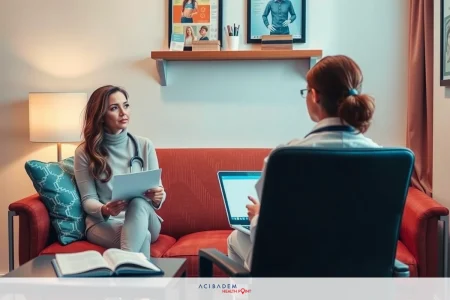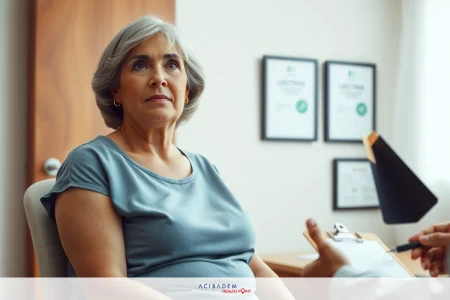Labral Hip Tear Symptoms Knowing the early signs of a labral hip tear is important for your health and movement. A key symptom is chronic hip pain. This pain gets worse when you’re active and it can stop you from doing your daily activities.
If you have a labral hip tear, you might also feel stiffness in your hip. This can make moving, sitting, and standing difficult. It’s important to look out for these symptoms.
Treating chronic hip pain and stiffness early is crucial. This helps you manage the condition better and keeps your life quality high. So, it’s wise to know what to watch for and get medical help if you suspect a labral hip tear.
Understanding Labral Hip Tear
The hip joint needs the labrum to work right. It’s a ring of cartilage around the acetabulum. This helps the hip joint move and stay stable. Knowing about the hip joint anatomy helps explain how labrum tears cause big problems.
When a labrum tear happens, the hip can’t work as it should. It hurts and feels unstable. This tear stops the hip from moving smoothly. It can lead to more problems like hip cartilage damage and make things like osteoarthritis worse.
A labrum tear is more than just pain. It can hurt the hip joint over time. Focusing on detecting and treating it early is key. This helps keep the hip joint healthy and avoids serious issues down the road.
Common Causes of Labral Hip Tears
Labral hip tears might happen because of hip impingement, trauma, and degenerative conditions. Knowing these reasons can help prevent and treat this painful issue.
Hip Impingement
Hip impingement, known as FAI, is a major reason for these tears. It happens when the hip bones touch the wrong way, hurting the labrum. This can lead to pain and less movement, especially for people doing sports that need a lot of hip motion.
Trauma and Injury
Labral hip tears can also be due to sudden accidents or sports injuries. Activities like soccer, hockey, and football can hurt the labrum. This is because of the quick moves and hard impacts in these sports.
Degenerative Conditions
As we get older, labral hip tears can become more common. This is because the labrum wears down over time. This makes it hard for the hip to move right and can lead to ongoing pain. Conditions like osteoarthritis can speed up this wearing down process.
Recognizing Hip Pain and Discomfort
Hip pain can really change how we live. It’s key to know the signs and how they affect our day. When pain lasts long, or gets worse, it touches everything we do. So, noticing it early and seeing a doctor is vital.
Impact on Daily Activities
Hip pain can make easy things hard. Like walking or sitting for long times. Does fun stuff like jogging or gardening seem impossible now? Knowing this can help find the right treatment, making life better.
When to See a Doctor
When hip pain doesn’t go away, it’s time to see a doctor. Clicking sounds, less movement, and more pain doing things are big signals. A doctor can help with the best plan for you. It’s all about making pain better.
Symptoms of Groin Pain
Groin pain often shows a big problem with the hip. It can be hard to find the real reason for this pain. It usually happens to athletes and active people. They move their hips a lot, which can cause problems like labral tears.
Also, groin pain might seem like other issues at first. It’s important to know how it connects to labral tears. Active people need to be careful because their movement can stress the hips. Knowing that hip problems can cause groin pain helps get the right treatment. Finding the real cause of the pain can make things better and stop it from lasting too long.
Noticing Joint Stiffness
Joint stiffness is a key sign of many hip problems, like labral hip tears. It’s important to know the different kinds of stiffness and what they mean for your hip health. This knowledge can help you find the right treatments. Let’s look at stiffness you feel in the morning and after you’ve rested a long time.
Morning Stiffness
In the morning, stiffness often sets in after sleeping. It can make moving hard when you first wake up. This stiffness can really limit your hip’s movement, which makes everyday tasks tough. People with arthritis may find their morning stiffness is worse. This is because their joints have less lubrication and their muscles are not active during the night.
Stiffness After Prolonged Rest
Stiffness also comes after you’ve been inactive for a while, like after sitting or lying down. This happens because your blood doesn’t flow as well and your joint fluid moves. If you already have trouble with hip movement or stiffness from arthritis, resting too long can make things worse. To keep your joints moving, it’s important to do some mild exercises and stretches during the day.
Labral Hip Tear Symptoms
Spotting the signs of a labral hip tear early is key to fast healing. The main hip injury symptoms to watch for are:
- Persistent hip pain, often felt deep in the groin.
- Having less movement ability, making bending or twisting hard.
- Feeling stiff, especially after sitting for a while or in the morning.
- Hearing clicks or feeling like your hip locks, which can make daily life tough.
Knowing these labral hip tear signs helps people get the right help. Quick treatment can prevent the symptoms from getting worse. It also improves the chances of a full recovery.
Dealing with Limited Range of Motion
Having trouble moving your hip joint? It can really affect your day. It might be hard to bend or stretch. This could be because of tears in the labrum. If not fixed, it can make things worse over time.
To get better hip movement, you need to manage it well. There are some things you can do:
- Physical Therapy: Doing special exercises with a pro can make your hips more flexible and strong.
- Stretching Routines: Stretching often can make you less stiff and help your hips move better.
- Low-Impact Activities: Swimming or riding a bike can make your hips move better without hurting them further.
- Use of Supports: Using braces or supports can make your hip feel better when you’re moving.
Adding these methods to what you do every day can make your hip mobility better. Always talk to a doctor before trying new things. They can tell you what’s best for your situation.
If moving your hips is really hard or painful all the time, it’s time for a full plan. Get help from a team that knows how to combine regular and new treatments. Fixing this early can keep things from getting worse and let you live without pain.
Identifying Hip Clicking and Locking
Hearing your hip click or lock can be scary and odd. It might mean there’s a problem like a tear in your hip’s labrum. It’s key to know these signs to get the right help and stop more issues.
Audible Clicking Sounds
Many people notice loud clicks in their hips when they move. This could happen when walking, running, or doing simple things. Often, a damaged hip labrum is to blame, messing up how the hip moves.
Episodes of Hip Locking
Sometimes, the hip can lock up and stop moving suddenly. This makes daily tasks hard to do. It’s usually because something is stopping the hip from moving smoothly, like a block in the joint or damage.
It’s important to catch the hip clicks and locks early. They really affect how you live and shouldn’t be overlooked. Talking to a doctor is a good idea to figure out what’s going on and how to treat it.
| Symptom | Description | Potential Causes |
|---|---|---|
| Hip Clicking Noises | Audible sounds during movements. | Hip labral damage or structural joint issues. |
| Hip Locking | Sudden, temporary immobility of the hip joint. | Internal obstructions or structural damage in the joint. |
| Hip Instability | General feeling of the hip joint being unstable. | Conditions like labral tears or hip dysplasia. |
How Hip Arthroscopy Can Help
If you’re having a tough time with hip pain from a labral tear, the hip arthroscopy procedure might be a big help. It’s a type of minimally invasive hip surgery. Surgeons use special tools and a tiny camera to check and work on the hip joint.
The best thing about this surgery is that doctors can find out what’s wrong inside without making big cuts. This helps detect problems like cartilage damage or labral tears, which regular tests sometimes miss. Then, it can fix these issues and take away things like bone spurs that cause pain and stop you from moving well.
People like this surgery because it heals faster and leaves small scars. Since it’s very precise, it doesn’t hurt the area around as much. This makes getting back to normal life, including sports, happen more quickly. Labral Hip Tear Symptoms
| Benefits | Hip Arthroscopy Procedure | Traditional Hip Surgery |
|---|---|---|
| Incision Size | Small (about 1 cm) | Large (10-30 cm) |
| Recovery Time | Weeks | Months |
| Scarring | Minimal | Significant |
| Pain Post-Surgery | Less Severe | More Severe |
If you have ongoing hip pain or notice it’s hard to move, you might have a labral tear. Talking to a hip specialist about the arthroscopic diagnosis can help. This hip arthroscopy procedure not only finds the problem accurately but also fixes it with less invasive surgery.
The Role of Acibadem Healthcare Group in Hip Treatment
The Acibadem Healthcare Group helps people with serious hip problems, such as labral hip tears. They are top in their field and use the best tech and treatments. Their goal is to help patients the best they can.
At Acibadem, people with hip issues get unique care. They use the newest tests and small surgeries, like hip arthroscopy. These methods help fix hips, so patients hurt less and move better.
Acibadem is known for its care that is all about the patient. Their hip doctors make special plans for each person’s needs. Because of this, they are a top pick for fixing labral hip tears and other hip problems.
FAQ
What are the common labral hip tear symptoms?
Labral hip tear symptoms often cause chronic pain in the hip and groin. There might be stiffness and a limited move range as well. Sometimes, your hip may click or lock, showing your hip joint isn't stable.
How does a labrum tear affect hip joint anatomy?
A tear in the labrum damages the cushioning cartilage in your hip joint. This makes the hip less stable and causes more pain. You might not be able to move your hip as freely as before.
What are the common causes of labral hip tears?
Hip impingement, injuries from sports, and conditions like osteoarthritis are common causes. These problems can wear down the hip joint over time.
How do hip pain and discomfort impact daily activities?
Hip pain can really make life hard. It can stop you from doing simple things like walking or bending. This can lower your quality of life and need medical care to fix.
When should I see a doctor for hip pain?
If you're feeling hip or groin pain all the time, see a doctor. Also, if your hip doesn't move much or hurts a lot, get help. It could be a labral tear or something else that needs to be checked.
Groin pain from a labral tear is often found in athletes. It causes deep hip discomfort that gets worse with activity.
How can I differentiate types of joint stiffness?
There's morning stiffness and stiffness after sitting too long. Knowing these types can help find the problem.
What are the indicators of a labral hip tear?
Key signs of a labral tear include long-lasting hip and groin pain. You might find it hard to move your hip or feel it click. Recognizing these early helps with treatment.
How can I deal with a limited range of motion in my hip?
To better move your hip, try physical therapy and special exercises. Sometimes surgery is needed to fix the tear.
What does hip clicking and locking signify?
If your hip makes noise or gets stuck, it could be unstable. It might be a labral tear. Treating it early can prevent more harm.
How can hip arthroscopy help with a labral tear?
Hip arthroscopy is surgery that can both diagnose and treat labral tears. It fixes the cartilage and makes your hip work better. This reduces pain and stiffness.
What role does Acibadem Healthcare Group play in hip treatment?
The Acibadem Healthcare Group is great at treating hip issues, including labral tears. They use the latest methods for diagnosis and treatment. They focus on you, making sure your hip health gets better.












